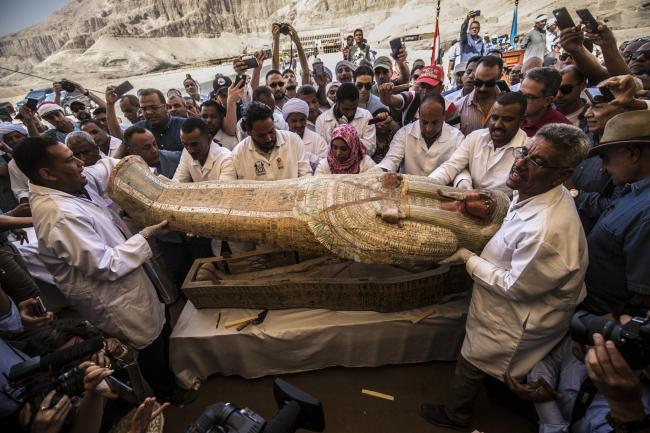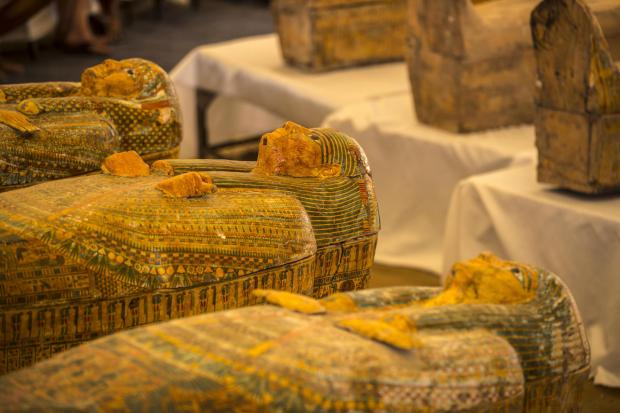https://www.thenational.scot/news/17986197.mummy-discovery-egypt-game-changer--/
Mummy discovery in Egypt is a game-changer – and here's why

A total of 30 wooden coffins containing mummies in excellent condition were found in the Valley of the Kings
WHAT'S THE STORY?
IN the past few days it has been revealed that 30 wooden coffins – known as sarcophagi and whose brightly coloured decorations are still brilliantly visible – have been found in what was the heart of ancient Egypt in the Valley of the Kings at Luxor.
Two of the coffins were opened in front of the world's media to show how the mummified bodies inside the wooden sarcophagi have been incredibly well preserved.
The discovery was made under a mound of sand at El-Asasif, a large, specially designed cemetery known as a necropolis – Greek for city of the dead – on the west bank of the River Nile in what was once West Thebes. The coffin site at the necropolis has been dubbed the "cachette of the priests" because it seems fairly certain that a high priest ordered the concealment of the coffins under the sand rather than in a tomb.
The find has sent archaeologists and Egyptologists into raptures because of its incredible rarity. As the Egyptian antiquities minister Khaled El-Enany said: "It is the first large human coffin cache discovered since the end of the 19th century."
BUT WASN'T THERE A BIG FIND OF MUMMIES BACK IN FEBRUARY?
THERE was indeed, but those were a "mere" 2400 years old or less, dating back to the Ptolemaic era of 305-30BC when a Macedonian Greek royal family ruled much of Egypt.
The mummies found at the Tuna El-Gebel site south of Cairo – about 200 miles north of Luxor – were deep inside a pharaonic tomb and only a few were inside sarcophagi so that they were not as well preserved as the latest coffins which, because they were hidden in the sand, are in a much better condition.
WHY IS THIS LATEST FIND A GAME-CHANGER?
THERE are a few reasons, the main one being the sheer age of the sarcophagi and their mummies. They date back almost 3000 years to the time of the 22nd dynasty, founded by Pharaoh Shoshenq I around 945 BC. Shoshenq is named in the Old Testament as Shishak, the Egyptian king who sacked Jerusalem.
The mummies inside the coffins included 23 adult males, five adult females and two children, and they are thought to be priests and their families.
Since they were so well concealed under sand, the usual problem for wooden sarcophagi did not happen – many coffins have been found in poor condition because of termites.
Given the mummies' age and the exquisite decorations on the sarcophagi, including hieroglyphics, scientists hope to learn much more than we already know about the 22nd dynasty, though the Egyptologists face a long process to decipher the mass of new material.
When they were discovered last week, the coffins were in two layers, with 18 coffins on top of 12 others. Experts were able to immediately identify the gender of the mummies – at that time men were buried with their hands closed but women were buried with their hands open.

According to experts, the elaborate decorations on the coffins were likely to compensate for the fact that they were not buried in proper tombs. The similarity in design suggests they were all made at the same workshop.
IS EGYPT NOW IN CHARGE OF ITS OWN ARCHAEOLOGY?
THE discovery of the coffins, which the finders have admitted was accidental – one of them was said to have stumbled over a coffin head – was made by a team of Egyptian archaeologists. In recent years the country has become ever-more protective of its sites and artefacts, and indeed has started to ask foreign museums to return Egyptian antiquities which often made their way abroad in dubious circumstances.
The country also now has dedicated archaeology institutes where a whole new generation of students are being trained in the science.
The Grand Egyptian Museum that the country is building near the famous Giza pyramids in Cairo will open next year and the coffins and mummies will be a star attraction there.
The museum has been under construction for more than 10 years and is intended to showcase Egypt's ancient treasures while drawing tourists to help fund its future development and more digs.
WHAT IS THE FUTURE FOR DISCOVERIES OF TOMBS AND SARCOPHAGI?
THE future is very bright for Egyptologists and archaeologists. Techniques are improving all the time and new technology is enabling more and more finds to be made.
It is a certainty that more finds will be made, and soon, as further excavations are already under way in the nearby area, which includes tombs dating back to the Middle, New Kingdom and Late periods of ancient Egyptian history – that's from 1994 BC to 332 BC.
El-Asasif itself has seen a number of recent discoveries. Last November, archaeologists announced that well-preserved mummies had been found in two tombs located near where the "cachette of the priests" was found.
The work of scientists around the globe, but especially in Egypt, is enabling us to have an ever-greater understanding of the people of ancient Egypt and the civilization which they inculcated that made them for hundreds of years the leading nation on this planet.
We owe them so much.
-- Sent from my Linux system.

No comments:
Post a Comment